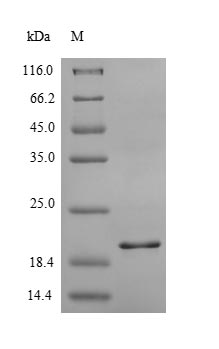The region for expressing recombinant Human CXCR2 contains amino acids 1-40. The calculated molecular weight for this CXCR2 protein is 20.6 kDa. This CXCR2 recombinant protein is manufactured in e.coli. The CXCR2 gene fragment has been modified by fusing the N-terminal 6xHis-SUMO tag, providing convenience in detecting and purifying the recombinant CXCR2 protein during the following stages.
Human C-X-C chemokine receptor type 2 (CXCR2) is a GPCR that plays a crucial role in immune responses and inflammation. Primarily expressed on the surface of various immune cells, including neutrophils, CXCR2 interacts with chemokines such as IL-8, to mediate cell migration and activation. This receptor is involved in directing immune cells to sites of infection or tissue damage. Beyond its role in immune function, CXCR2 has been implicated in various pathological conditions, including inflammatory diseases and cancer. Research on CXCR2 contributes to understanding immune system regulation and provides insights into potential therapeutic strategies for inflammatory disorders and cancer treatments.






